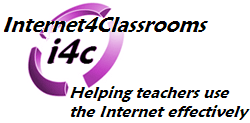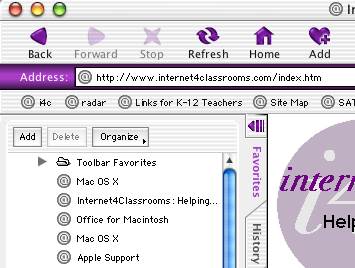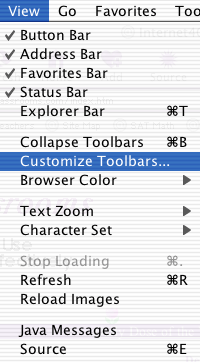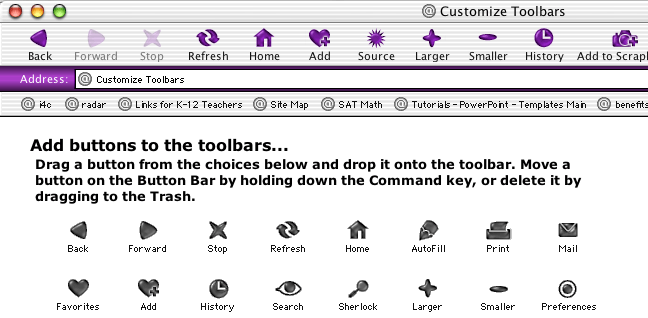

|
|
|
|
Navigating with Internet Explorer Buttons
|
Using the Standard Button toolbar
The image below is a clickable image map. Place the tip of your mouse pointer on any button in the image below. If your mouse pointer turns to a finger, a single click with the left side of your mouse button will carry you to an explanation of how to use the button. Some buttons have been added to the default toolbar. This tutorial will show you how to add or remove buttons later.

Back - Gently click one time with your mouse button to go back to the page that you were looking at before you followed the link to take you to the current page.
Back history - Place your cursor over the Back button, but do not click. Do you notice a small triangle pops up at the lower left tip of the button? That is the Back History list. Gently click and hold your mouse button down. That action brings up a list of the sites you have visited using this browser window. To avoid clicking the Back button two times to get back to "http://www.internet4classrooms.com/on-line.htm," slide the mouse pointer down to that entry and click one time with your mouse. These entries are in chronological order with the most recently visited site at the top of the list.

Forward - This button will not be available unless you have used the Back button at least once. If you have used the back button, and the forward button is not grayed out, clicking one time on the Forward button will take you to the page you just left when you clicked on the Back button.
Forward history - Place your cursor over the Back button, but do not click. Do you notice a small triangle pops up at the lower right tip of the button? That is the Forward History list. Gently click and hold your mouse button down. That brings up a list of the sites you have visited and then used the Back button to return from using this browser window. To avoid clicking the Forward button three times to get back to "http://www.internet4classrooms.com/mac10_built_in.htm," slide the mouse pointer down to that entry and click one time with the button on the left side of your mouse. These entries are in chronological order with the most recently visited site at the top of the list.

Stop - Select this button to stop the current download. If you tried to follow a link and the IE logo in the top right corner of your window is still spinning, the browser is still trying to complete your request. If too many seconds pass and you do not get to the page, put the tip of your mouse pointer on the Stop button and click one time. Try the link again. Often this allows you to see the page quicker than if you just waited for your first click on the link to finish.
Refresh - Place the tip of your mouse pointer on the Refresh button and click one time. This asks for the most recent version of the page that you are on. There are several reasons for using this button
- If you used the stop button before all of the page downloaded, use Refresh to get a complete page
- If you know the page has changed since the last time you visited it, use Refresh to see the newest version of the page.
- If you are on a page which updates frequently (like CNN), use Refresh to see the most recent information
Home - The page that is displayed when you first launch Internet Explorer is known as the Home page. No matter how many pages you have visited in your Internet session, you can instantly get back to that first page by placing the tip of your mouse pointer on the Home button and clicking one time. "Home again, home again! Jiggedy Jig!"
Favorites - To see a Favorites pane, go to the View menu and select Explorer bar if it is not open. Click on the top button, Favorites.

To get rid of the Explorer bar, go back to the View menu and deselect Explorer.
History - To see where you have been on the Internet, or where a student of yours has been, place the tip of your mouse pointer on the History button and gently click one time. That opens a pane of sites on the left side of your browser window. Clicking one time with your mouse on any domain folder in the list causes the folder to display all of the sites visited at that Internet domain. Clicking one time with your mouse on any link within a domain folder causes IE to return to that page.

Print - Select this button to print a copy of the Internet page you are viewing.
Removing items from the Toolbar
Not all of the toolbar buttons included with Internet Explorer are appropriate for the classroom. Some are not necessary and some could be distracting. You decide which buttons that would be in your classroom and remove them from the toolbar. Many of these would be great for personal productivity at home, but not for student use in the classroom. To make those changes move your mouse pointer to the View menu and click one time. Slide the pointer down to Customize Toolbars... and gently click one time.


The Default toolbar -
Task - Part 1: Choose two items to be removed, and one item to be added. Customize the toolbar on your browser. Part 2: Go back to the Customize Toolbar window and Reset the toolbar to the way it looked before you made the three changes in Part 1.

Custom Search
|
Visitors since November 2000 |
Memphis, TN |
Internet4Classrooms is a collaborative project developed by Susan Brooks and Bill Byles
to send email, add @internet4classrooms.com to sbrooks or bylesb
Return to Internet4Classrooms home
